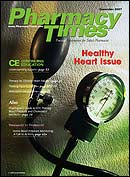Publication
Article
Pharmacy Times
DIABETES WATCH
Diabetics Face Silent Heart Disease
The records of 1046 patients with diabetes and the absenceof heart disease found that 16.7% had reduced left ventricularejection fraction (LVEF), which translates to the heart pumpingabnormally low amounts of blood with each beat.
Reporting recently in the American Heart Journal, leadinvestigator Panithaya Chareonthaitawee, MD, said that thepresence of reduced LVEF corresponded with a reducedsurvival rate of 10 years—29% versus 57% in patients witha normal LVEF. Because heart failure can be treated andresults improved, he noted that a potential role exists forscreening patients who are in the asymptomatic stages ofreduced LVEF.
He cautioned that findings are only preliminary and largerstudies are needed to confirm the results.
Charcot Foot Growing Among Diabetes Patients
Physicians with the American College of Foot and AnkleSurgeons (ACFAS) want patients with diabetes and their careproviders to know about a growing complication of the disease—Charcot foot.
Charcot foot is a sudden softening of the foot's bonescaused by severe neuropathy. The condition can cause jointloss, fractures, collapse of the arch, ulcers, amputation, andeven death. Because most patients with Charcot cannot feelpain in their lower extremities, they continue walking on thefoot, causing more injury.
Although it is a rare complication, the prevalence of the conditionappears to be growing as more Americans are diagnosedwith diabetes. The ACFAS stresses the importance ofeducating patients, physicians, and caregivers. For more information,visit the ACFAS Web site at www.FootPhysicians.com.
Insulin Puzzle May Be Solved
Researchers have isolated the PKCepsilon (PKCe) enzymethat is present during diabetes and blocks the availability ofinsulin, according to a study reported in the October 2007issue of Cell Metabolism. The findings may explain whyinsulin production fails in individuals with type 2 diabetes.
Lead investigators said that the findings could significantlyadd to the development of a medication that would inhibitPKCe and allow the pancreas to produce enough insulin forpatients with type 2 diabetes. The researchers noted, however,that the effect of PKCe to restore the pancreatic abilityto produce insulin was a surprise. Whereas existing therapiesstimulate the body to make more insulin, no existingdrug acts as a PKCe inhibitor to restore an individual's normalfunction. The researchers believe that more researchcould protect individuals who are at high risk for developingthe disease.
Use A1C Levels to Screen for Diabetes
Researchers at Charles R. DrewUniversity (Los Angeles, Calif) foundthat measuring a patient's glycosylatedhemoglobin levels (A1C) could be usedto test for diabetes, according to astudy reported in Diabetes Care (September2007).
To determine what A1C levels shouldlead to more testing for diabetes, theresearchers examined data from 4935participants in the 1999-2004 NationalHealth and Nutrition Examination Survey.The findings indicated that 3280patients were at normal levels, 1485patients had prediabetes levels (100mg/dL to 125 mg/dL), and 170 patientshad previously undiagnosed diabetes(126 mg/dL or higher), based on fastingplasma glucose levels.
"This should increase the early diagnosisof diabetes so that appropriatetreatment can be instituted to preventthe complications of the disease," saidresearcher Mayer B. Davidson, MD.
Diabetes Self-care Ignored with Depression
Poor adherence to self-care in patients with type 2 diabetesis associated with depression. For the study, theresearchers compared the effects of depression on 879patients with diabetes from 2 primary care clinics.
The participants were surveyed using the HarvardDepartment of Psychiatry/National Depression ScreeningDay Scale (HANDS), the Summary of Diabetes Self-CareActivities, and self-reported medication adherence. Overall,the findings showed that 19.3% of the patients met theHANDS criteria for possible major depression, and 66.5% hadsome depression symptoms without meeting the criteria forprobable major depression.
Of the participants with probable major depression, 59.4%had depression documented in their medical records, and48.8% had been prescribed an antidepressant drug. Theresearchers found a significant association between majordepression and poor adherence to diet and exercise. Thesepatients faced a 2.3-fold increased risk of missing medicationdoses in the previous week. (The findings were reported inDiabetes Care, September 2007.)
F A S T F A C T : The number of individuals with undiagnosed diabetes totals 6.2 million.







